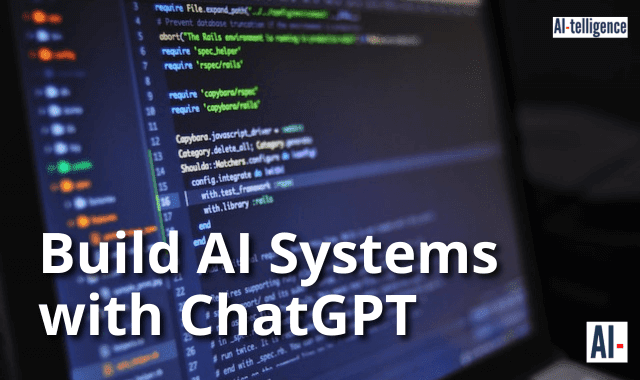How to build AI Systems with ChatGPT?
 How to build AI Systems with ChatGPT |
AI System. As the field of artificial intelligence continues to grow, more and more businesses and organizations are turning to chatbots and other AI systems to improve their customer service and automate routine tasks.
One of the most exciting developments in this field is the use of ChatGPT, a powerful natural language processing tool developed by OpenAI.
With its ability to understand and respond to human language in a natural and intuitive way, ChatGPT is rapidly becoming a favorite tool for building intelligent AI systems.
AI System: The Benefits of Using ChatGPT
One of the biggest advantages of using ChatGPT in AI systems is its ability to understand natural language. This means that AI systems can be trained to recognize and respond to a wide range of phrases and expressions, making them much more versatile and effective than traditional rule-based systems.
ChatGPT can also learn from the data it receives, making it an ideal tool for building adaptive AI systems that can improve over time.
Another major benefit of using ChatGPT in AI systems is its ability to generate natural language responses that sound like they were written by a human.
This makes AI systems much more engaging and user-friendly and can help to build trust and rapport with customers and users.
ChatGPT as a Natural Language Processing Tool
At its core, ChatGPT is a natural language processing tool that is designed to understand and generate human language. It works by analyzing the context of a conversation and generating a response that is appropriate for that context.
This means that ChatGPT can be used to build a wide range of AI systems, from chatbots that can answer customer service inquiries to language models that can generate realistic text in a variety of contexts.
How to Build AI Systems with ChatGPT
Building AI systems with ChatGPT requires a solid understanding of natural language processing and machine learning.
There are a number of different tools and frameworks available for building ChatGPT-based AI systems, including OpenAI's GPT-4 API, which provides a powerful set of tools for training and deploying AI models.
A step-by-step guide to building AI systems with ChatGPT:
- Define the problem: Determine the use case for your AI system and identify the specific problem that it will solve. This will help you to define the scope of your project and ensure that your AI system meets the needs of your target audience.
- Gather data: Collect and organize data that is relevant to your problem. This data will be used to train your ChatGPT model, so it should be representative of the language and context that your AI system will be working with.
- Train your model: Use the data you have gathered to train your ChatGPT model. This process will involve feeding your model with example inputs and outputs, allowing it to learn from the patterns in the data.
- Test your model: Once your model is trained, test it to ensure that it is accurate and reliable. This will involve running it through a range of scenarios and evaluating its performance.
- Integrate your model: Once you are satisfied with the accuracy and reliability of your model, integrate it into your AI system. This may involve using APIs or other tools to connect your model to your frontend or backend systems.
- Monitor and maintain your system: Once your AI system is up and running, it is important to monitor its performance and maintain it over time. This may involve tweaking your model to improve its accuracy or making updates to your system to keep up with changing user needs.
By following these steps, you can build effective and reliable AI systems using ChatGPT that meet the needs of your target audience and help you to achieve your business or organizational goals.
AI Systems: Challenges and Limitations of Using ChatGPT
While ChatGPT is a powerful tool for building AI systems, it is not without its limitations. One of the biggest challenges is ensuring that your model is accurate and reliable, as even small errors in natural language processing can lead to major problems in AI systems.
There are also concerns about bias in natural language processing, as ChatGPT may inadvertently learn and reinforce harmful stereotypes and biases.
Conclusion: The Promise of ChatGPT in the Future of Machine Learning
Despite these challenges, ChatGPT holds great promise for the future of machine learning and artificial intelligence. As more businesses and organizations begin to use AI systems to automate routine tasks and improve customer service, the demand for natural language processing tools like ChatGPT will only continue to grow.
By understanding the benefits and limitations of ChatGPT, we can build more effective and reliable AI systems that can help to improve our daily lives in countless ways.
In the years ahead, we can expect to see even more powerful natural language processing tools emerge, and these tools will be critical for building the next generation of AI systems. As we continue to push the boundaries of machine learning and artificial intelligence, we must remain vigilant in ensuring that our AI systems are safe, reliable, and free from bias. Regulating artificial intelligence is, perhaps, an option to consider.
With the right tools and the right mindset, we can build a future where AI systems are a force for good, helping us to achieve our goals and improve our lives in ways we never thought possible.

.png)
Comments
Post a Comment